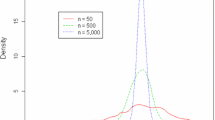Abstract
Suppose that a regression model includes a regressor that is a dummy variable that takes a non-zero value for only one observation. Then the least squares estimates of the coefficients of the other regressors are the same as would be obtained by dropping that observation from the sample and omitting the dummy variable. This is well-known, but is frequently overlooked by practitioners. In this note we extend this result to the case of instrumental variables estimation, and to maximum likelihood estimation of models for count data, binary dependent variables, and duration data. These extensions also allow for the inclusion of many such “impulse-indicator” variables in the model, not just one.
Similar content being viewed by others
References
Cameron, A.C., and P.K. Trivedi. 1986. Econometric models based on count data: Comparisons and applications of some estimators and tests. Journal of Applied Econometrics 1: 29–54.
Cox, D.R. 1972. Regression models and life tables (with discussion). Journal of the Royal Statistical Society, B 34: 187–220.
Giles, D.E. 2017. On the inconsistency of instrumental variables estimators for the coefficients of certain dummy variables. Journal of Quantitative Economics 15: 15–26.
Greene, W. 2008. Functional forms for the negative binomial model for count data. Economics Letters 99: 585–590.
Hendry, D.F., and C. Santos. 2005. Regression models with data-based indicator variables. Oxford Bulletin of Economics and Statistics 67: 571–595.
Kaplan, E.L., and P. Meier. 1958. Nonparametric estimation from incomplete observations. Journal of the American Statistical Association 53: 457–481.
Lancaster, T. 1992. The Econometric Analysis of Transition Data. Cambridge: Cambridge University Press.
Salkever, D.S. 1976. The use of dummy variables to compute predictions, prediction errors, and confidence intervals. Journal of Econometrics 4: 393–397.
Santos, C., D.F. Hendry, and S. Johansen. 2008. Automatic selection of indicators in a fully saturated regression. Computational Statistics 23: 317–335.
Acknowledgements
I am very grateful to Ryan Godwin and Jacob Schwartz for helpful discussions relating to an earlier version of this paper, and to an anonymous referee for their helpful comments.
Author information
Authors and Affiliations
Corresponding author
Ethics declarations
Conflict of interest
This research was not funded. There are no conflicts of interest/competing interest.
Additional information
Publisher's Note
Springer Nature remains neutral with regard to jurisdictional claims in published maps and institutional affiliations.
Rights and permissions
About this article
Cite this article
Giles, D.E. Some Consequences of Including Impulse-Indicator Dummy Variables in Econometric Models. J. Quant. Econ. 20, 329–336 (2022). https://doi.org/10.1007/s40953-022-00294-y
Accepted:
Published:
Issue Date:
DOI: https://doi.org/10.1007/s40953-022-00294-y



